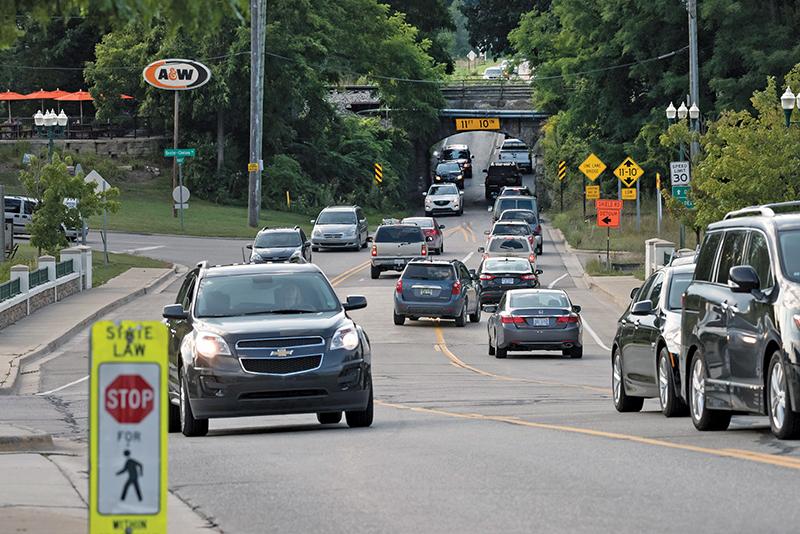Traffic congestion has Dexter tearing its collective hair out, so let’s start with something light: You can sort out longtime residents from newcomers by watching the traffic passing under the pretty stone viaduct at the edge of downtown. Old-timers know that two SUVs can pass through the narrow arch simultaneously, though “it’s snuggy in there,” says John Hansen, who’s lived in Dexter for more than forty years. If you see a little Prius or Ford Focus hesitating where the road dips, you’re looking at an out-of-towner or a recent addition to Dexter’s growing population.
There are a lot of cars in Dexter. On June 1, the city conducted a traffic count during peak hours at Main St.’s intersections with Broad, Central, and Baker. City council recently OK’d a four-story building at 150 Jeffords, a step toward higher-density living whose environmentally noble aim is to let people live closer to where they work, shop, and dine. But twenty-two downtown dwelling units won’t dent Dexter’s rush-hour traffic jams.
“As long as farmers grow houses instead of soybeans, we’ll have more traffic,” says Doug Fuller, chair of the Washtenaw County Road Commission (WCRC). “Every house in a subdivision generates ten car trips per day–that’s the number that planners use.”
This isn’t the worst problem a city can have. “As a businessperson, I’m happy to see a lot of traffic. It’s a sign of a thriving community,” says Coley O’Brien. He owns the A&W and recently bought Terry B’s (see Marketplace Changes, p. 35), both offering prime views of rush-hour congestion. “But as a resident, it’s frustrating.” He often has to make the dangerous left turn from Dexter-Chelsea Rd. towards the underpass, roughly at the point where Main St. becomes Island Lake Rd. “You’re looking into a black hole. You can’t see if anyone is coming through” the viaduct.
In the A-through-F report-card parlance used by civil engineers, the traffic study gave Dexter three Fs: for traffic westbound on Main at Broad during the afternoon rush hour, and for traffic southbound on Central at Main in both the morning and afternoon traffic peaks. The report included a sly note on commuter psychology: “Some of the values do not align with driver perception”–basically, people are crankier about morning traffic, but the data show that it’s worse in the afternoon. The report’s suggestions for improving traffic flow downtown are nothing drastic–adjusting traffic arrows and signal timing.
Not included in the survey, because it’s under county jurisdiction, is that scary junction of Dexter-Chelsea and Island Lake. The county’s favored traffic solution these days is roundabouts–Washtenaw County has more than any other county in the state–and this intersection may eventually get one.
“I don’t think a roundabout would help there,” says David Carroll, who navigates the intersection daily to visit his wife in the Chelsea Retirement Community. He, like O’Brien, fears the yawning black cavern under the viaduct when he makes a left from Dexter-Chelsea onto Island Lake, but he doesn’t like roundabouts either.
A traffic light? That would only “aggravate the situation,” Carroll says. “It would stop people who don’t need to be stopped, and they would all pile back as far as the DQ.” His suggestion: “maybe a three-way stop on the town side of the bridge.”
Commissioner Fuller expressed surprise to hear so many complaints about that intersection. The spot he usually hears about is the five-way snafu at the convergence of Huron River Dr., Joy Rd., and Central. It’s another potential spot for a roundabout.
One reason we’re seeing so many roundabouts is that the feds help pay for them. Improving traffic flow not only eases commuter frustration, explains WCRC engineer Mark McCulloch, it cuts the “idle time” vehicles spend waiting at stoplights and the amount of exhaust they emit while they sit. Federal grants pay for roundabouts when they can be proven to improve air quality.
WCRC and the city have already qualified for $1.3 million in grants that will pay for two roundabouts on Baker Rd., at the intersections with Shield and Dan Hoey. At an open house at Creekside Elementary, WCRC staff explained that as soon as school shuts down next June, Baker traffic will be shunted to Parker Rd. Barring weather delays, Baker will reopen with its two new roundabouts before school starts next fall.
The WCRC, meanwhile, is embarking on a PR campaign to teach drivers how to navigate roundabouts. “It’s the thirty-five-to-sixty-five-year-olds who need the most help,” McCulloch says. “Young people get it in driver’s ed. Seniors get a bad rap, but actually they’re more cautious by nature.”
At a recent Dexter Forum, senior citizens John Hansen and Dan Chapman gave a hearty endorsement of roundabouts–though not so much because of age-related trepidation as because they are well-traveled. “I like them,” says Chapman, a pediatrician. “They’ve been using them in Europe for a long time.”


